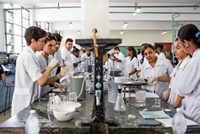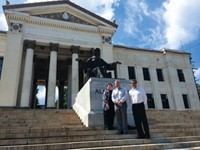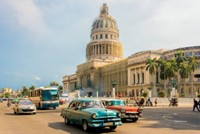Advertisement
Grab your lab coat. Let's get started
Welcome!
Welcome!
Create an account below to get 6 C&EN articles per month, receive newsletters and more - all free.
It seems this is your first time logging in online. Please enter the following information to continue.
As an ACS member you automatically get access to this site. All we need is few more details to create your reading experience.
Not you? Sign in with a different account.
Not you? Sign in with a different account.
ERROR 1
ERROR 1
ERROR 2
ERROR 2
ERROR 2
ERROR 2
ERROR 2
Password and Confirm password must match.
If you have an ACS member number, please enter it here so we can link this account to your membership. (optional)
ERROR 2
ACS values your privacy. By submitting your information, you are gaining access to C&EN and subscribing to our weekly newsletter. We use the information you provide to make your reading experience better, and we will never sell your data to third party members.
Business
IYC Profile: Cuba
In this U.S.-embargoed country, ACS members such as Alberto Núñez-Sellés seek a greater connection to the world
by Carmen Drahl
January 31, 2011
| A version of this story appeared in
Volume 89, Issue 5

The mango extract that chemist Alberto Núñez-Sellés studies encapsulates Cuba’s turbulent past as well as its future. The Mambises, guerrillas who fought with imperial Spain in hopes of liberating Cuba, used mango stem bark to heal wounds on the battlefield. Before them, Cuba’s 19th-century African slaves used similar extracts to treat headaches and diarrhea. Today, Cubans produce the brand-name mango stem bark extract Vimang as an antioxidant nutritional supplement.


Núñez-Sellés, who lives in Havana, is studying Cuban biodiversity through mango extracts such as Vimang. But he’s rather uninterested in isolating individual molecules from the extracts, something that typically happens en route to developing a drug from a naturally occurring substance. Instead, he believes Vimang’s multimolecular context is critical for its therapeutic properties. “You will never succeed in developing a drug from a natural product using the same principles and rules as you would for a synthetic moiety,” he says. He points to a series of small clinical trials on the supplement, some of which show improvements in markers of oxidative stress in HIV-infected patients, to argue that mixtures of compounds can be useful as medications (Pharmacol. Res., DOI: 10.1016/j.phrs.2007.01.004).
An analytical chemist by training, with a Ph.D. from the Academy of Sciences of Czechoslovakia, Núñez-Sellés evolved into a medicinal chemist during the 20 years in which he led Cuba’s Center of Pharmaceutical Chemistry. Today, he is a health-quality manager at Cuba’s Ministry of Public Health.
He’s hardly the only Cuban with an interest in improving his country’s health through natural resources. Indeed, drug development and biotechnology research are the most visible research areas in Cuba, according to the 2010 Science Report by the United Nations Educational, Scientific & Cultural Organization (UNESCO). Other emerging priorities in Cuba include energy research, nanotechnology, and mitigation of disasters caused by climate change.
To hear Núñez-Sellés, a former five-term president of the Cuban Chemical Society, tell it, chemistry in Cuba has two faces: one of success, the other of impotence. The country is at the forefront of vaccine research, has developed its own cholesterol-lowering pill, and has multiple research institutes where chemistry is the focus. And it all happened within the past few decades. Scientific infrastructure was virtually nonexistent in Cuba until after the 1959 Cuban Revolution, when Fidel Castro made research a national priority.
But Cuban chemists have always had to do more with less, and their situation has become especially acute since the loss of subsidies from the former Soviet Union after its collapse in 1991. Furthermore, the effects of the U.S. economic embargo on Cuba, which began in 1960, seep into every chemist’s workday, Núñez-Sellés says. “I prefer to call it a ‘blockade,’ ” he adds, noting that “it can take more than six months to receive a chemical.”
Research supplies usually come from Western Europe and Canada. When a U.S. product is the only option, “you have to go through Canada or Mexico,” usually at a significant price hike, Núñez-Sellés explains.
Obtaining information is also a challenge. Only 13% of Cuba’s population had Internet access in 2008, according to UNESCO’s report. For those who can reach the Internet, “searches that take only a few minutes in the U.S. might take a few hours in Cuba,” Núñez-Sellés says.
Access to information and to the worldwide chemical community were Núñez-Sellés’ motivation for joining the American Chemical Society. Although the Cuban Chemical Society had more than 1,200 members in 2009, ACS currently has only six members in Cuba. From the U.S. government’s standpoint, Cubans are permitted to become ACS members. Núñez-Sellés suspects that the requirement that membership dues be paid in currency convertible to U.S. dollars is the reason for the low number.
ACS provides valuable connections through newsletters and networking opportunities, but Internet limitations rule out resources such as ACS webinars, Núñez-Sellés says. He wishes Cuban chemists had more opportunities to interact with U.S. chemists and wonders whether ACS might be able to help facilitate more collaboration between the two groups. He also hopes that U.S. scientific societies will band together to encourage the U.S. government to lift the embargo.
This series celebrating the International Year of Chemistry offers a window into the lives of ACS members around the world.







Join the conversation
Contact the reporter
Submit a Letter to the Editor for publication
Engage with us on Twitter